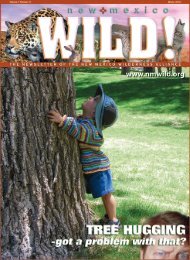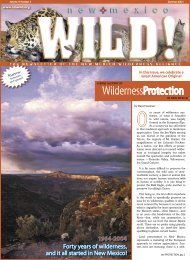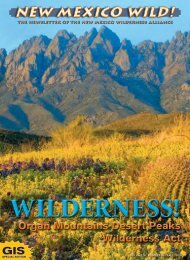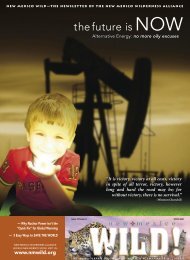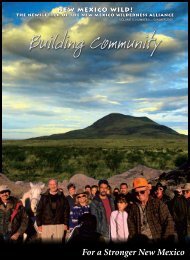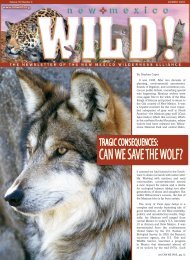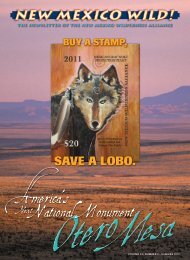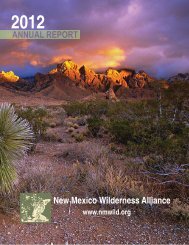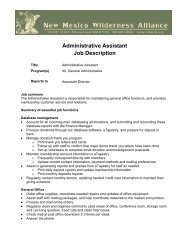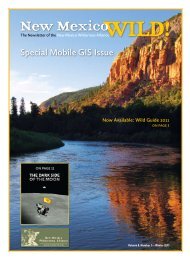FIGHTING THE GOOD FIGHT - New Mexico Wilderness Alliance
FIGHTING THE GOOD FIGHT - New Mexico Wilderness Alliance
FIGHTING THE GOOD FIGHT - New Mexico Wilderness Alliance
Create successful ePaper yourself
Turn your PDF publications into a flip-book with our unique Google optimized e-Paper software.
Daily, the United States comes<br />
closer to consummating the<br />
devil’s bargain: sacrifi cing the<br />
soul of our wildest public lands in<br />
return for days, weeks, or at most<br />
months of energy from oil and gas.<br />
Places like Arctic National Wildlife<br />
Refuge in Alaska and Otero Mesa<br />
in <strong>New</strong> <strong>Mexico</strong> are now a few Congressional<br />
and court decisions away<br />
from seeing their wildness turned<br />
into a wasteland of roads, wells,<br />
and pipelines. If industrialized oil<br />
and gas development does occur,<br />
those living nearest these lands<br />
will suffer greatest. One example<br />
is Otero Mesa’s independent ranchers,<br />
who face losing their traditional<br />
way of life to industrialized drilling.<br />
Often, unique wildlife populations<br />
and important water supplies are<br />
threatened. Native American peoples<br />
(such as the Gwich’in Nation<br />
of northern Canada and Alaska) risk<br />
losing their cultural identity if ancestral<br />
areas are scarred beyond recognition.<br />
However, public lands like Arctic<br />
National Wildlife Refuge and Otero<br />
Mesa belong to all Americans.<br />
Whether these lands fall to shortterm<br />
energy development, or continue<br />
the American tradition of<br />
preservation, depends partially on<br />
Americans far from these<br />
places.<br />
I attended the College<br />
of Wooster, in Wooster,<br />
Ohio, for the past four<br />
years, but was born and<br />
raised in <strong>New</strong> <strong>Mexico</strong>. I<br />
was brought back in large<br />
part because of our land.<br />
Recently, I visited Otero<br />
Mesa and then Wooster,<br />
to find out whether students<br />
and staff there<br />
would be willing to join the <strong>New</strong><br />
<strong>Mexico</strong> <strong>Wilderness</strong> <strong>Alliance</strong> and<br />
others in protecting America’s largest<br />
wild grassland.<br />
The sun was<br />
setting beyond<br />
the Organ Mountains<br />
when my<br />
brother Douglas<br />
(age 11)<br />
and I arrived on<br />
Otero Mesa. As<br />
nightfall settled<br />
in, three mountains-Alamo,<br />
Wind, and Flattop-<br />
remained<br />
visible, silhouetted<br />
by moonlight<br />
in the southern<br />
sky. Later,<br />
near the only<br />
watering hole for<br />
miles, a cowboy<br />
named Dennis<br />
pointed us in the<br />
direction of the<br />
Alamo Mountain<br />
campground. He was checking on<br />
cattle, and seemed happy to learn<br />
we planned to camp nearby.<br />
During our time on this grassland,<br />
we heard more coyotes than<br />
cars, and saw cattle roaming the<br />
free range<br />
instead<br />
of feedlots.<br />
Atop<br />
Alamo<br />
Mountain,<br />
Douglas<br />
remarked,<br />
“it would<br />
be easy<br />
to get lost<br />
out there,<br />
but that’s<br />
what<br />
makes<br />
it<br />
neat”, as we surveyed Otero Mesa’s<br />
rolling plain, punctuated with its<br />
mountains and rocky ridges. Petroglyphs<br />
covering entire boulders on<br />
Alamo Mountain were reminders of<br />
Otero Mesa’s early human history,<br />
dating back thousands of years.<br />
Cattle heading toward a solitary<br />
water tank reinforced the continued<br />
presence of fourth and fifth generation<br />
ranching families, as well as<br />
the scarcity of surface water. Leaving,<br />
we caught a glimpse of the only<br />
native pronghorn antelope herd left<br />
in <strong>New</strong> <strong>Mexico</strong>.<br />
These pronghorn, which are<br />
found only in North America, symbolized<br />
the balance of Otero Mesa.<br />
Having been around for more than<br />
a million years they continue to<br />
coexist with cattle, cougars, coyotes,<br />
and cowboys. Their herd<br />
even remains strong enough to be<br />
hunted. Such balance is rare in a<br />
world that increasingly sways to<br />
one extreme or the other.<br />
Wayne County, where the College<br />
of Wooster is located, is losing<br />
this balance. The area has watched<br />
farmland and forests steadily disappear,<br />
replaced by national franchises<br />
and housing developments. However,<br />
there are still several excellent<br />
outdoor areas nearby. The wildest<br />
is Killbuck Wildlife Refuge, the<br />
largest freshwater marsh in Ohio.<br />
Killbuck’s 2000 acres of river fed<br />
swamps, enclosed by rolling hills,<br />
are delightful in any season. Winter<br />
ice makes previously marshy areas<br />
accessible, while warmer months<br />
bring joyous symphonies produced<br />
by thousands of frogs, birds, crickets<br />
and other creatures too numerous<br />
to name.<br />
In making the case to protect<br />
Otero Mesa I wanted to emphasize<br />
the value of places like Killbuck,<br />
while pointing out that this worth is<br />
magnifi ed many times over on a<br />
landscape, 1.2 million plus acres,<br />
as large and as wild as Otero Mesa.<br />
However, for many of the fi fty<br />
people who attended my presentation,<br />
common sense was the<br />
best argument for not drilling oil<br />
and gas wells across Otero Mesa.<br />
Carroll Meyer, a Presbyterian minister<br />
who grew up one of nine children<br />
on a family farm, called it<br />
“ridiculous to endanger all that land<br />
and especially the water supply<br />
for so little energy”. Will Driscoll, a<br />
geology major, bypassed the water<br />
issue and instead seized on state’s<br />
rights, writing to President Bush,<br />
“The overriding of state’s rights [to<br />
drill on Otero Mesa] stands in strong<br />
contrast to your purported traditional<br />
conservative values”. Nick<br />
Baggett, who spent a summer commercial<br />
fi shing in Alaska, focused<br />
on public lands. “I would like to<br />
stress the concept of public lands.<br />
These lands are for public use, not<br />
industry”. One letter simply said,<br />
“Invest the money used for drilling<br />
in alternative energy development<br />
so we can have a real solution”.<br />
Seven Wooster students and staff<br />
joined NMWA as members during<br />
my stay. Dozens wrote letters to<br />
President Bush, and scores signed<br />
the petition to make Otero Mesa a<br />
National Conservation Area.<br />
Otero Mesa will always be a local<br />
treasure, but its signifi cance<br />
stretches far beyond <strong>New</strong> <strong>Mexico</strong>’s<br />
borders. Keeping Otero Mesa wild<br />
means listening to the American<br />
public, and if Wooster is any example,<br />
there are many who are willing<br />
to take a stand in defense of our<br />
wildest public lands.<br />
Page 18 Spring 2005



